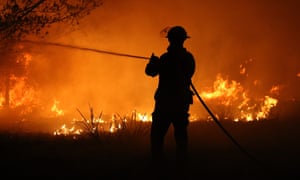Atmospheric concentration of major greenhouse gas forecast to hit 417
parts per million in May with bushfires contributing 2% of increase
Australia’s bushfire crisis is expected to contribute up to 2% of
what scientists forecast will be one of the largest annual increases in
atmospheric carbon dioxide on record.
The atmospheric concentration of the heat-trapping gas is projected to peak at more than 417 parts per million in May, and average about 414.2 parts per million for the year, according to the forecast by the British Met Office. It is a 2.74ppm increase above the 2019 average.
Science agencies have associated concentrations of more than 450ppm with average temperature rise of 2C above pre-industrial levels, a point at which some catastrophic effects of global heating may become irreversible.
In its statement explaining the forecast, the Met Office Hadley
Centre highlighted the role of the Australian bushfires in contributing
to the unusually large forecast annual rise.The atmospheric concentration of the heat-trapping gas is projected to peak at more than 417 parts per million in May, and average about 414.2 parts per million for the year, according to the forecast by the British Met Office. It is a 2.74ppm increase above the 2019 average.
Science agencies have associated concentrations of more than 450ppm with average temperature rise of 2C above pre-industrial levels, a point at which some catastrophic effects of global heating may become irreversible.
Richard Betts, a professor with the Met Office and the University of Exeter, said human-induced climate change and local weather patterns had contributed to the hot, dry weather that played a key role in the severity of the Australian bushfires, which in turn increased emissions.
Fires have affected more than 12m hectares of country this season, including more than 5m hectares in New South Wales.
Betts said fossil fuel burning and deforestation had driven a year-on-year increase in carbon dioxide levels since 1958, when readings began at the Mauna Loa Observatory in Hawaii, but the rate of the increase fluctuated depending on how much was absorbed by forests and other ecosystems.
The response of ecosystem carbon sinks was expected to be weaker than normal for a second year running as warmer and drier conditions limited the ability of plants to grow and absorb carbon dioxide, increasing the risk of wildfires that released more emissions.
“While human-caused emissions cause the carbon dioxide rise in concentration, impacts of weather patterns on global ecosystems are predicted to increase the rise by 10% this year,” the statement says.
It says emissions from the Australian fires contribute “up to one-fifth of this increase”, or up to 2% of the total rise.
Emissions from bushfires are usually considered to be climate neutral in carbon accounting, based on the assumption that forest regrowth absorbs a similar amount of carbon dioxide as was released. But scientists increasingly warn this is likely to be optimistic as many burned areas never recovered to their pre-fire state.
Australia contributes about 1.3% of annual global emissions under UN greenhouse accounting rules.
Bill Hare, the chief executive of Climate Analytics, said the wildfire emissions would not be counted in Australia’s emissions due to the way the country constructed its greenhouse gas reporting. “Along with other accounting tricks, such as Kyoto carry over, it is a clear global signal of the effect of Australia avoiding its responsibility to take real action,” he said.
Ken Thompson, a former NSW deputy commissioner for fire and rescue, said it should not be a surprise that Australia’s fires were making a mounting contribution to the climate crisis. “Our emissions from bushfires keep going up as a result of our failure to address climate change, creating the conditions for even worse fire seasons to come,” he said.
Met Office research suggests a 2C rise in global temperatures is likely to lead to between 20 and 30 extra days of “very high” fire risk in south-western and eastern Australia each year. It found the area at risk of “extreme” fire danger conditions could increase by about 20m hectares, roughly the size of Victoria.

No comments:
Post a Comment